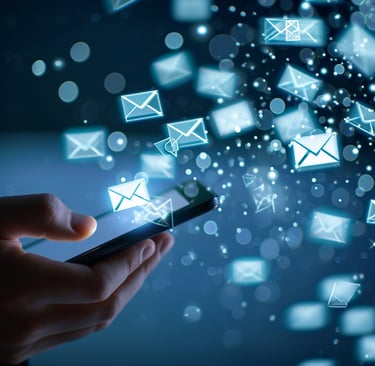
5 Proven Email Marketing Strategies to Boost Engagement & Drive Conversions for Businesses
Discover the top 5 email marketing strategies to skyrocket your business's engagement and conversion rates. Learn how segmentation, personalization, compelling content, automation, and analytics can transform your email campaigns. Start boosting your email effectiveness today!
EMAIL MARKETING
Bashaar Ahmed
2/19/202413 min read
1. Tailoring Your Approach to Different Audiences
To succeed in today's dynamic digital landscape, it is essential to understand that one-size-fits-all strategies rarely deliver desired results. This especially holds true in the realm of email marketing, where reaching out to diverse audiences require a customized and differentiated approach. When it comes to tailoring your approach, email marketing strategies primarily revolve around understanding your audience demographic, their needs, preferences, behaviours, and tailoring your messages accordingly. This kind of segmentation allows businesses to send relevant and resonating messages, which further drives engagement and eventually results in higher conversion rates.
Personalization and segmentation are critical components of successful email marketing strategies. By segmenting your subscriber list, you can deliver targeted and personalized emails, which would inevitably lead to increased open and click-through rates. More and more businesses are realizing the importance of leveraging customer data to segment their audience into demographic, psychographic, or behavioural groups. This segmentation then forms the basis of personalized email campaigns, keeping the content relevant and interesting for each unique audience segment, thereby increasing the chances of the conversion.
Segmenting Your List for Targeted Messaging
Segmenting your email subscriber list is a powerful strategy for boosting email engagement. Think of your audience not as a monolithic entity but as a collection of unique individuals with different needs and interests. By dividing your list into segments based on relevant factors such as demographics, past purchase behavior, or engagement level, you give yourself the capability to send targeted messages that resonate more closely with your recipients.
This approach enhances the relevance of your content for each subscriber, capturing their attention and fostering a stronger connection with your brand. Moreover, segmenting your list allows for A/B testing of different email designs, subject lines, and content types. The results from these tests provide valuable data that guides ongoing refinements to your email strategy, systematically increasing the effectiveness of your campaigns. By using segmentation to deliver more personalized content, you can significantly boost email engagement, representing a key step towards realizing your business goals.
Personalization Techniques to Boost Engagement
Personalization plays a significant role in amplifying email conversion rates. By providing subscribers with customized content tailored to their interests and behaviors, businesses can profoundly boost the relevancy of their emails. As a result, there's an upsurge in the likelihood of recipients engaging with the email by clicking through or making a purchase. This relevancy could often be the deciding factor that transforms email recipients from passive readers into active customers.
Techniques for boosting email engagement via personalization can be as simple as using the recipient's name in the email. Or as subtle as leveraging user data to cater content that aligns with their purchase history or browsing habits. Notably, the personalized content should extend beyond the email body and subject line, reaching as far as the landing pages that the emails link to. For more advanced personalization efforts, businesses might explore dynamic content, essentially creating different versions of the same email to meet the varied interests of their diverse subscriber list. This elevates the customer experience and fosters stronger relationships with the brand.
Key Email Marketing Strategies to Elevate Your Engagement and Conversions
Email marketing stands as a cornerstone of business strategy, offering unmatched reach and ROI. Our blog, "5 Proven Email Marketing Strategies to Boost Engagement & Drive Conversions for Businesses," dives deep into effective techniques that cut across industries, ensuring your messages not only reach the inbox but also resonate with the audience. From the art of segmentation and personalization to the science of timing, automation, and analytics, we unravel the keys to crafting campaigns that convert. Whether you're a startup or an established enterprise, these insights will empower you to leverage email marketing to its full potential, driving growth and fostering lasting customer relationships. Join us as we explore how to transform your email marketing into a powerful tool for business success.


2. Developing Engaging Content
In the realm of email marketing, developing engaging content has a paramount significance. Succinctly put, it can make or break your campaign. The core element associated with this is employing email personalization techniques. These techniques allow businesses to reach out to their customers on a more personal and individualized level, which could significantly increase engagement rates.
Drafting engaging content goes beyond merely plugging in a customer's name into an email template. It involves delving into subscriber preferences, purchase history, and other behavioral data to curtail the content that resonates with them the most. Email personalization techniques shed light on such key insights that can make your email content significantly more relevant and engaging, thereby fostering stronger relationships with your customers.
Crafting Compelling Subject Lines
Crafting compelling subject lines is an indispensable element of successful email marketing automation. Subject lines, often seen as a small detail, actually serve as the first point of contact and the make-or-break factor contributing significantly to whether an email gets opened. Refined lines can grab your audience's attention, spark intrigue and set the tone for the content that’s about to unfold.
Subject lines must be delicately designed with a clear purpose – to invite openers into the email body. This leverages the emailing experience whilst ensuring that value is unmistakably communicated from the offset. The perfect blend of brevity, relevance, and suspense can stimulate curiosity, prompting recipients to explore further. This is where the virtue of email marketing automation comes into play, offering data-driven insights to refine and target your subject lines for maximum impact.
The Art of Email Design
The cornerstone of any successful email marketing campaign lies in the artful and purposeful design of the email itself. Professionally curated design elements not only help your emails stand out in a crowded inbox but also play a key role in conveying your brand's tone and personality. Incorporating visually appealing graphics, consistent color schemes, and easily navigable layout can significantly elevate the reader's experience. Remember, an aesthetically pleasing email design can influence the reader's perception of your brand, thereby impacting the click-through and conversion rates.
Contrary to popular belief, crafting a compelling email design goes beyond mere graphics and visuals. A major component of effective email design includes strategically structuring your content for easy comprehension. Short, punchy paragraphs interspersed with relevant headers and bullet points can maximize readability and ensure your key messages don't get lost in a block of text. To reinforce your brand identity, the choice of typography should reflect your brand's personality while being legible across devices. Ultimately, the goal should be to create a balanced, visually cohesive design that seamlessly blends valuable content with striking visuals to captivate your audience.
To achieve this, consider the following elements:
Consistent Branding: Ensure your email design aligns with your brand's overall aesthetic. This includes consistent use of logos, color schemes, and typography across all emails to maintain a cohesive brand identity.
Clear Messaging: The purpose of your email should be immediately clear to the reader. Avoid cluttering your design with unnecessary information or visuals that may distract from the main message.
Ease of Navigation: Structure your content in a way that guides readers through the email effortlessly. Use headers and bullet points to break up text and highlight key points.
Mobile-Friendly Design: With an increasing number of people checking their emails on mobile devices, it is crucial to ensure that your design is responsive and displays correctly on various screen sizes.
Use of Visual Elements: Incorporate relevant images, infographics or videos into your design to make it more engaging. However, remember not to overdo it as too many visuals can overwhelm the reader.
Personalization: Personalizing emails can significantly increase engagement rates. This could include addressing recipients by their name or tailoring content based on their preferences or past behavior.
In conclusion, mastering the art of email design involves striking a balance between aesthetics and functionality while staying true to your brand's personality. A well-designed email not only engages its readers but also reinforces brand recognition and loyalty.
3. Optimizing Send Times and Frequency
Effective email marketing isn't just about what you send; it's also about when you send it. Time optimization can significantly affect the open and click-through rates of your campaigns. Rather than blanket sending, conducting meticulous market research is essential so that you can align your send times with when your recipients are most likely to check their emails. This still requires constant testing and adjustments as recipients' habits can change over time and vary across different platforms and geographic locations.
Simultaneously, the frequency of your emails also plays a crucial role in the success of your email marketing strategy. Ensuring you strike the right balance is vital as bombarding your subscribers' inboxes may lead to an increased unsubscribe rate. Subscribers may consider an excess of emails as spam. Conversely, too few emails could cause your subscribers to forget about your business and subsequent lack of engagement in whatever you’re offering. Regularity and consistency are keys, but they must be well-balanced with your content's relevance and value.


Determining the Best Time to Send Emails
Unquestionably, knowing the optimal time to dispatch your emails is pivotal for ensuring their effectiveness. This factor directly impacts your emails' open rates, as sending messages at an hour when your audience is most likely active significantly heightens the possibility of your content being noticed and digested. Astoundingly, studies have displayed that emails transmitted on Tuesdays and Thursdays at around 10:00 AM have the highest open rates, as most people tend to check their emails during working hours (Radicati, 2017).
Yet, these metrics should not be uniformly adhered to. The preferred time to send emails relies on a myriad of factors, including the nature of the email, the demographics of your audience, and their typical living and online patterns. For instance, a B2B company may find that their target audience is more likely to open emails during traditional working hours, while a B2C company targeting millennials might see better open rates during the evening (Mailchimp, 2016). Therefore, continuous testing is essential to comprehend these altering trends and custom-tailor your approach to your particular audience and their distinctive lifestyle. This can be achieved by operating A/B tests on different sending times and analyzing the resulting data to discover your optimal send time.
Finding the Right Frequency
Understanding the right frequency to send emails to your audience is a crucial component of an effective email marketing campaign. Sending too many emails can lead to audience fatigue, diminishing the effectiveness of your message and increasing the likelihood of unsubscriptions. On the other hand, sending too few emails can result in missed opportunities to engage your audience, lower levels of brand recall, and decreased chances of conversion.
To establish the optimal email send frequency, it is necessary to monitor and analyze your email performance metrics regularly. Factors such as open rates, click-through rates, and conversion rates can give an indication of whether your audience finds the current email frequency agreeable. Consider running A/B tests with various sending frequencies to discern which yields the best engagement levels. Also, pay close attention to any changes in these metrics when you adjust your email frequency. Remember, the right frequency varies depending on your sector and the nature of your audience. Consider providing an option for your subscribers to choose how often they wish to receive your emails. This gives your audience a sense of control and may help to maintain higher rates of engagement in the long run.
4. Automating for Efficiency and Effectiveness
In the contemporary digital marketing landscape, automation has become an essential tool for fostering efficiency and effectiveness. As businesses grapple with an ever-expanding customer base, effectively managing and tailoring their marketing efforts is made exceedingly more manageable through thoughtfully executed automation strategies. Businesses that cultivate a sophisticated understanding of how to leverage automation not only streamline their operations but also significantly enhance the quality of their outreach, ultimately driving engagement and conversion rates.
Email automation, in particular, offers a robust platform for personalized and consistent customer interaction. In essence, it refers to the practice of sending time or action triggered emails to subscribers with relevant information. By automating marketing processes that would otherwise be tedious and time-consuming, businesses are able to better allocate their resources towards achieving strategic goals. Sophisticated automation techniques such as drip campaigns aid in maintaining continuous customer engagement, making timing and messaging more precise, hence, driving conversions.
References:
[Email Marketing Automation- HubSpot](https://www.hubspot.com/email-marketing-automation)
[Why You Need Email Marketing Automation - CampaignMonitor] (https://www.campaignmonitor.com/resources/guides/email-marketing-new-rules/)
Implementing Email Automation
Email automation refers to the process of sending time or action triggered emails to subscribers with relevant information. The implementation of this strategy is a game-changer for many businesses, offering a significant way to nurture leads, keep customers engaged, and save time for marketers. Automation allows you to deliver personalized content at scale, fostering meaningful relationships with your subscribers that drive business growth.
Setting up a successful email automation strategy, however, requires thoughtful planning and attention to detail. It begins with understanding your audience's behavior, interests, and where they fall in the purchase journey. Then, with this insight, you design emails tailored to those specific characteristics, further segmenting your audience for even more personalized and targeted messaging. Using email automation platforms like MailChimp or Constant Contact can assist businesses in managing these tasks, eliminating the need for manual sending and providing valuable data for future campaigns. Remember, effective email automation is not a one-size-fits-all solution, but a continuous process that involves testing, analysis, and refinement.
Effective Drip Campaigns
Drip campaigns can play a significant role in elucidating user engagement and driving conversions. This strategy involves sending out a series of automated emails to specific segments of your email list, tailored according to certain predefined triggers or user actions. By implementing this tactic, your business can offer consistent touchpoints that guide prospects through the sales funnel, subsequently improving conversion rates and fostering customer loyalty. Furthermore, drip campaigns free up a considerable amount of time, allowing you to focus on other pertinent areas of your marketing strategy.
Personalizing these messages enhances the relevancy and makes your audience feel valued, further boosting engagement. A well-structured drip campaign aims to deliver the right content at the right time; whether it’s a 'Welcome' sequence for new subscribers, 'Abandoned Cart' emails for hesitant shoppers, or 'Re-engagement' campaigns for inactive customers. Efficacious drip campaigns are not solely about the explicit promotion of your products or services; but also about imparting value to your audience, building trust, and fostering a strong brand-customer relationship. Consistently analyzing your campaign's performance through key metrics is vital in refining your strategy for enriched outcomes. For instance, email open rates, click-through rates, and conversion rates provide valuable insight into how your campaign is performing, thereby offering a pathway for necessary adjustments.
5. Analyzing and Refining Your Strategy
Data analytics and performance metrics form the crux of a successful email marketing strategy. By consistently delving into the patterns of your subscribers’ engagement and interaction, businesses can unearth a treasure trove of invaluable information. This data, which may include metrics such as open rates, click-through rates, bounce rates, and conversion rates, is instrumental in assessing the efficacy of your email marketing strategy. It is crucial to maintain the strategic agility to adapt your strategy based on this analysis.
Refining your strategy is just as vital as its initial development. The convenience of metric-driven insights allows businesses to test and optimize a wide range of factors. From subject lines and email designs to send times and segmentation efforts, every aspect can be optimized for better performance. An important part of refinement is A/B testing, which lets you compare the performances of two different versions of an element and streamline your efforts accordingly. This continuous process of analysis and refinement is the cornerstone of a dynamic, result-driven email marketing strategy.


Essential Metrics for Email Marketing
To truly understand the impact of your email campaigns, it's crucial to focus on key performance indicators (KPIs). Open rates and click-through rates (CTR) offer a glimpse into how engaging your content is, while conversion rates reveal the effectiveness of your calls-to-action. Don't overlook bounce rates and unsubscribe rates; these metrics can signal the health of your email list and the relevance of your content. By regularly analyzing these data points, you can refine your strategies, ensuring your email marketing efforts contribute significantly to your business goals.
The Power of A/B Testing
A/B testing, or split testing, is a powerful tool to optimize your email marketing campaigns. By creating two versions of an email—changing one element such as the subject line, call-to-action, or email design—you can see which performs better with your audience. This method provides concrete data on what resonates with your subscribers, allowing you to make informed decisions that enhance the effectiveness of your campaigns. Implementing A/B testing can lead to higher engagement rates, improved content relevancy, and ultimately, increased conversions.
Work with us!
Ready to take your email marketing to the next level? Don't let the opportunity to engage and convert your audience slip through your inbox. Book a meeting with us today, and let's unlock the full potential of your email campaigns together. Our team is here to help you craft personalized strategies that not only reach your audience but resonate with them. Click here to schedule your strategy session and start driving meaningful results with your email marketing efforts


Conclusion
In the journey to elevate your email marketing, the strategies discussed here serve as your roadmap to success. By understanding your audience, crafting compelling content, optimizing timing, leveraging automation, and consistently analyzing your results, you can transform your email efforts into a powerful driver of engagement and conversions. Remember, the key to email marketing is continuous optimization and adaptation to your audience's evolving needs. With these strategies in hand, you're well-equipped to harness the full potential of email marketing to achieve your business objectives.


Frequently Asked Questions!
What are some techniques to tailor my approach when communicating with different audiences?
Tailoring your approach involves understanding the unique needs and preferences of your different audiences. This could involve segmenting your email list for targeted messaging or personalizing your content to boost engagement.
How can I effectively segment my email list for targeted messaging?
Segmenting your email list involves grouping your subscribers based on common characteristics such as demographics, buying behavior, or engagement levels. By doing so, you can send more relevant and personalized content to each segment, thereby increasing engagement and conversions.
How can I boost engagement through personalization techniques?
Personalization techniques can range from simple tactics like using the recipient's name in the email, to more complex strategies like tailoring the content based on the recipient's past behavior or preferences. Personalized emails tend to have higher open and click-through rates.
How can I develop engaging content for my emails?
Developing engaging content involves crafting compelling subject lines that entice recipients to open the email, and designing the email in a way that is visually appealing and easy to read. The content should be relevant, valuable, and interesting to the recipient.
What are some tips for determining the best time to send emails?
The best time to send emails can depend on a variety of factors, such as your audience's habits and preferences, the type of content you're sending, and the day of the week. It's recommended to test different send times and analyze the results to determine the optimal time for your audience.
How can I find the right frequency for sending emails?
Finding the right frequency involves striking a balance between staying top of mind with your audience and not overwhelming them with too many emails. It's important to monitor your engagement metrics and adjust your frequency based on your audience's response.
How can I implement email automation to improve efficiency and effectiveness?
Email automation involves using software to automate the process of sending emails based on predefined triggers or conditions. This could include welcome emails, follow-up emails after a purchase, or drip campaigns to nurture leads over time.
How can I analyze and refine my email strategy?
Analyzing and refining your strategy involves tracking key metrics such as open rate, click-through rate, and conversion rate. You should also conduct regular A/B testing to identify which elements of your emails are working and which ones could be improved. This ongoing process of analysis and refinement is crucial for improving the effectiveness of your email marketing.
